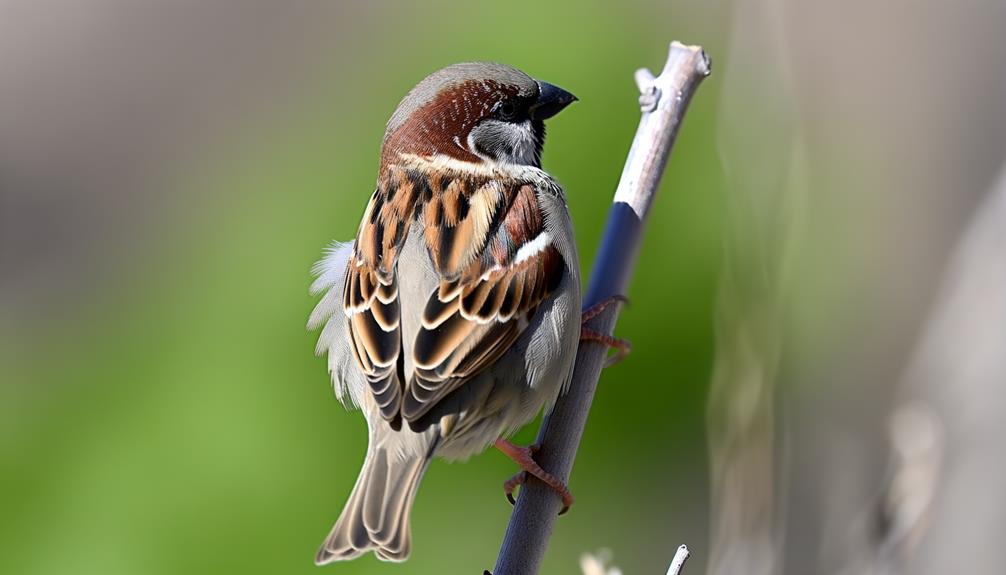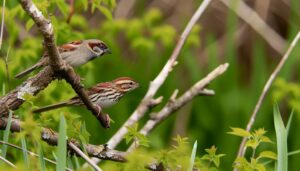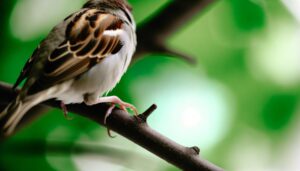Measuring a House Sparrow: From Bill Tip to Tail Tip
The House Sparrow, Passer domesticus, exhibits specialized anatomical features from bill tip to tail tip. Its stout, conical beak, robust for seed consumption, shifts into a head with distinct brown and gray streaks and a pale eye ring for visual recognition.
Beneath, the neck and throat display vocal adaptations essential for communication. The body showcases aerodynamic wings and a well-developed digestive system.
Agile legs and keratinized claws support balance during perched activities. Finally, the tail, comprised of twelve rectrices, plays a pivotal role in flight adjustments and social signaling.
Next, explore deeper insights into their ecological adaptations and behaviors.

Key Takeaways
- The house sparrow has a stout, conical beak for seed consumption.
- It features twelve rectrices in its tail, aiding in flight and communication.
- Males have distinct crown and nape colors, while females have different cheek and throat coloration.
- The house sparrow's robust mandibles are made of keratin for seed processing.
- Sexual dimorphism is evident, with males generally having a longer tail.
Bill Structure
The bill structure of the house sparrow (Passer domesticus) is characterized by its stout, conical shape, which is particularly well-adapted for seed consumption. This morphological adaptation enables the bird to exert significant force, efficiently cracking open a variety of seeds.
The robust mandibles, composed of keratin, facilitate precision in manipulating small food items, such as grains and seeds, essential for their diet. The upper mandible, slightly overhanging the lower, enhances the ability to husk seeds. Additionally, the tomia, or cutting edges, are sharp and assist in slicing through seed coats.
The overall bill morphology reflects evolutionary optimization for granivory, ensuring the house sparrow's survival in diverse environments. This specialized structure underscores the intricate relationship between form and function in avian species.
Head and Eyes
The head of the house sparrow displays a distinct feather color pattern, often with a gray crown and chestnut brown nape, which aids in species identification.
Particularly, the eye features a subtle, yet distinct, pale eye ring that enhances visual recognition.
The beak, adapted for seed consumption, exhibits a robust, conical shape that underscores its functional importance in the bird's feeding behavior.
Feather Color Patterns
Distinctive color patterns adorn the heads and eyes of house sparrows, featuring a combination of rich browns, striking blacks, and subtle grays that facilitate both camouflage and social signaling.
The males typically exhibit more pronounced coloration compared to females, with the following key features:
- Crown and Nape: Males have a gray crown contrasted by chestnut nape and sides, while females display a more uniform brown.
- Eye Stripe: A bold black stripe extends from the beak through the eye and beyond, prominent in males.
- Cheek and Throat: Males possess a black bib and white cheeks, whereas females have a more muted brown cheek and throat area.
These patterns play an essential role in species identification and mating displays, highlighting the complexity of avian plumage.
Eye Ring Details
Encircling the eyes of house sparrows, an inconspicuous yet crucial eye ring can be observed, often varying subtly between males and females. This eye ring, typically white or pale in coloration, serves as a significant identifier in ornithological studies. In males, the eye ring is generally more pronounced during the breeding season, while in females, it remains consistently subtle. The eye ring's visibility aids in the identification of age and sex, contributing to a deeper understanding of the species' phenotypic variations.
| Characteristic | Description |
|---|---|
| Color | White or pale |
| Seasonal Variation | More pronounced in males during breeding |
| Identification Utility | Distinguishes age and sex |
Such details are crucial for accurate field observations and contribute to broader ecological studies involving house sparrows.
Beak Shape Function
Examining the beak shape of house sparrows reveals its crucial role in foraging efficiency and feeding habits. The conical structure, characterized by a short, stout form, is finely tuned for seed consumption. This specialized morphology allows sparrows to exert substantial pressure, cracking open tough seed coats with ease.
Importantly, the beak shape also facilitates:
- Versatile Diet: Adaptation to consume a variety of seeds and insects.
- Precision Handling: Enhanced manipulation of small food items.
- Energy Efficiency: Minimizing energy expenditure during feeding.
Observations indicate that the beak's robustness is complemented by keen eyesight, essential for locating food sources. This integration of beak functionality with visual acuity underscores the sparrow's evolutionary adaptations for survival in diverse environments.
Neck and Throat
The neck and throat of the House Sparrow exhibit distinct feather patterns. Males display a noticeable black bib that varies in size with age and season.
Vocalizations emanate mainly from this region. The bird produces a series of chirps and calls essential to its communication repertoire.
Seasonal color changes are also observed. The throat feathers often darken during the breeding season, providing visual cues to other sparrows.
Feather Patterns Observed
Distinctive feather patterns on the neck and throat of the House Sparrow (Passer domesticus) display a complex interplay of colors and textures that aid in species identification and behavioral studies. This region showcases a variety of hues, primarily shades of brown, gray, and black, forming intricate and often symmetrical patterns. Importantly, the male House Sparrow presents a bold black bib on the throat, which varies in size with age and dominance.
- Brown and gray streaks: These provide camouflage against predators.
- Black bib: More pronounced in males, indicating maturity and social ranking.
- Seasonal variations: Feather patterns shift subtly between breeding and non-breeding seasons.
Such detailed observations assist ornithologists in understanding mating systems, territoriality, and social structures within sparrow populations.
Vocalization and Songs
Vocalization in the House Sparrow involves a complex array of calls and songs, primarily produced by the syrinx located at the junction of the trachea and bronchi, which are modulated by the muscles of the neck and throat. These vocalizations serve various functions, including mate attraction, territory defense, and social communication.
Male sparrows are particularly noted for their repetitive, chirping songs, which can vary in pitch and rhythm. The intricacies of their calls are controlled by fine muscle adjustments in the neck and throat, allowing for a diverse range of sounds.
Additionally, juveniles learn these vocal patterns through mimicry and social interactions, highlighting the importance of vocal learning in their development.
Seasonal Color Changes
Throughout the year, the House Sparrow exhibits notable seasonal color changes in the feathers of its neck and throat, which are influenced by factors such as hormonal fluctuations and environmental conditions. These changes serve various adaptive functions and are particularly evident in males.
During the breeding season, heightened testosterone levels result in:
- Darker pigmentation: Males display a more pronounced black bib, enhancing their attractiveness to potential mates.
- Enhanced contrast: The neck and throat feathers gain a stark contrast against the lighter surrounding plumage, signaling fitness.
- Feather wear: Seasonal wear can lead to color fading, revealing underlying pigmentation differences.
In contrast, non-breeding periods are marked by a more subdued coloration, reflecting reduced hormonal activity and environmental wear. This dynamic interplay underscores the complexity of avian seasonal adaptations.
Wing Anatomy
Examining the wing anatomy of the House Sparrow reveals a complex structure, intricately adapted for flight, comprising primary and secondary feathers that provide both lift and maneuverability.
The primary feathers, numbering ten, are long and robust, essential for propulsion and speed during flight. Conversely, the secondary feathers, typically numbering around six to nine, are shorter and contribute to the bird's lift and sustained flight capabilities. These feathers are anchored to the ulna bone of the wing, ensuring stability and control.
Additionally, the wing's covert feathers, which overlay the primary and secondary feathers, streamline the wing and enhance aerodynamic efficiency. This intricate arrangement allows the House Sparrow to perform agile maneuvers and maintain prolonged periods of flight.
Chest and Abdomen
Continuing from the intricacies of the wing anatomy, the chest and abdomen of the House Sparrow house essential organs and muscle groups necessary for respiratory efficiency and overall well-being. The pectoral muscles, prominently located in the chest region, are crucial for flight, enabling the powerful wing beats required for sustained aerial maneuverability.
The abdominal region is equally important, containing the digestive tract and other vital systems.
- Respiratory System: The complex arrangement of air sacs interspersed throughout the chest ensures optimal oxygen exchange.
- Digestive Tract: The crop, stomach, and intestines are intricately designed for efficient food processing.
- Heart and Circulatory System: Centrally positioned to facilitate rapid nutrient and oxygen delivery.
These components collectively sustain the metabolic demands of an active avian lifestyle.
Legs and Feet
Anchoring the House Sparrow's agility and balance, the legs and feet are intricately structured to support both perching and foraging behaviors. The tarsometatarsus, a fused bone in the lower leg, provides strength and leverage.
Each leg culminates in a highly dexterous foot equipped with three forward-facing toes and one backward-facing toe (hallux). This anisodactyl arrangement is essential for gripping branches and maneuvering diverse terrains. The keratinized claws at the tips of each toe enhance traction and facilitate efficient scratching in search of food.
Additionally, the muscles and tendons in the legs exhibit remarkable adaptability, allowing rapid adjustments during flight takeoff and landing. Collectively, this complex anatomy guarantees the House Sparrow's adeptness in its varied ecological niches.
Tail Features
Frequently acting as an essential tool for balance and maneuverability, the tail of the House Sparrow is composed of twelve rectrices, or tail feathers, arranged in a fan shape. These feathers are vital to the bird's flight dynamics, providing both stability and control during aerial maneuvers.
The tail also plays a pivotal role in communication, with subtle movements conveying signals to other sparrows.
Key features of the House Sparrow's tail:
- Length Variation: Tail length can vary slightly between males and females, providing a subtle sexual dimorphism.
- Wear and Tear: Frequent use leads to seasonal wear, necessitating periodic molting.
- Feather Structure: Each rectrix is robust yet flexible, enabling precise adjustments during flight and perching.
This structure is crucial for the House Sparrow's adaptability and survival.
Conclusion
The house sparrow, from bill tip to tail tip, presents a fascinating study in avian anatomy.
The intricate structure of its bill contrasts with the delicate nature of its head and eyes.
The neck and throat exhibit a smooth shift into the robust wing anatomy, while the chest and abdomen offer a glimpse into its respiratory efficiency.
Legs and feet, sturdy yet agile, juxtapose with the tail features that provide aerodynamic precision.
This intricate composition underscores the evolutionary marvel of the house sparrow.






